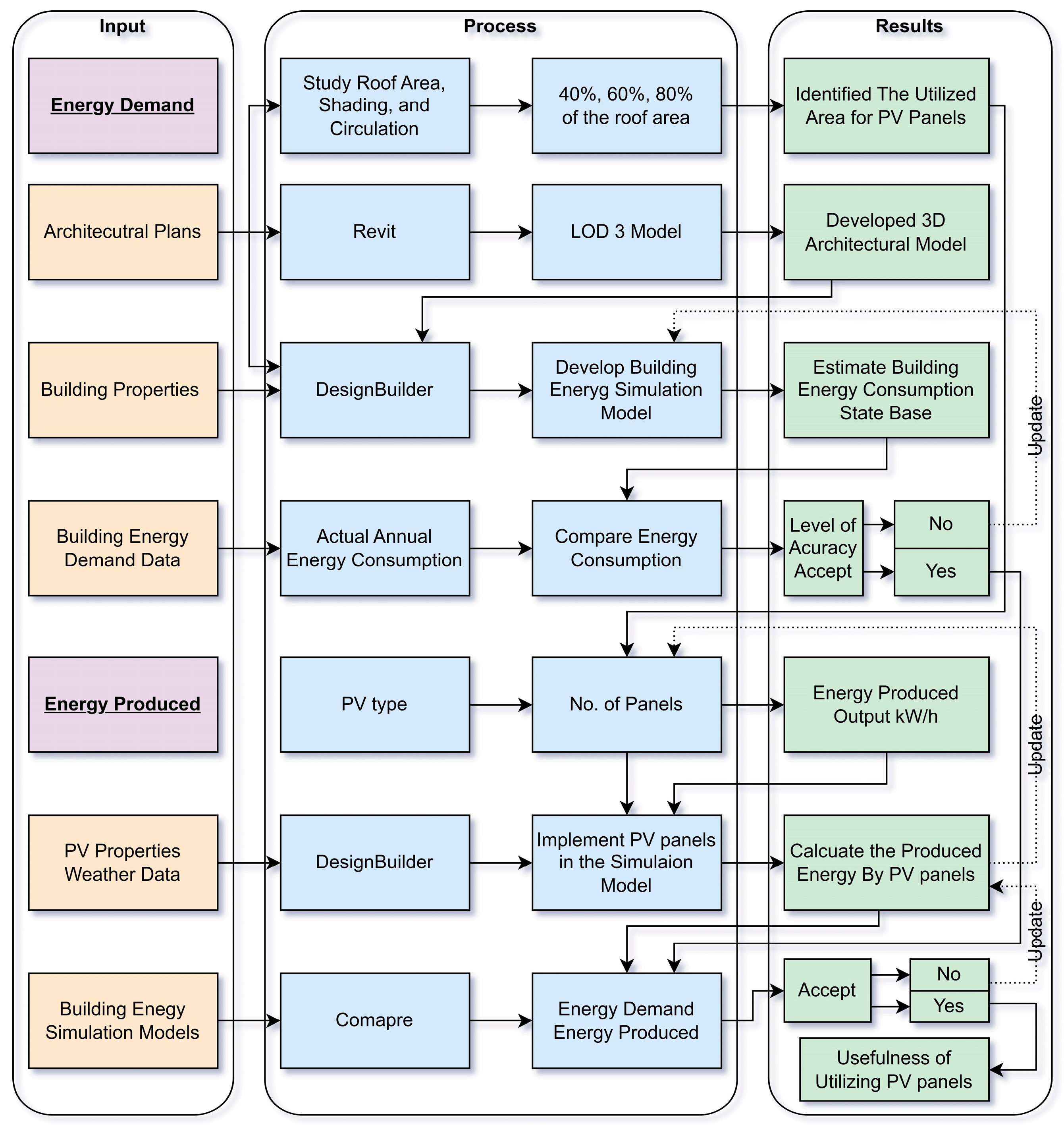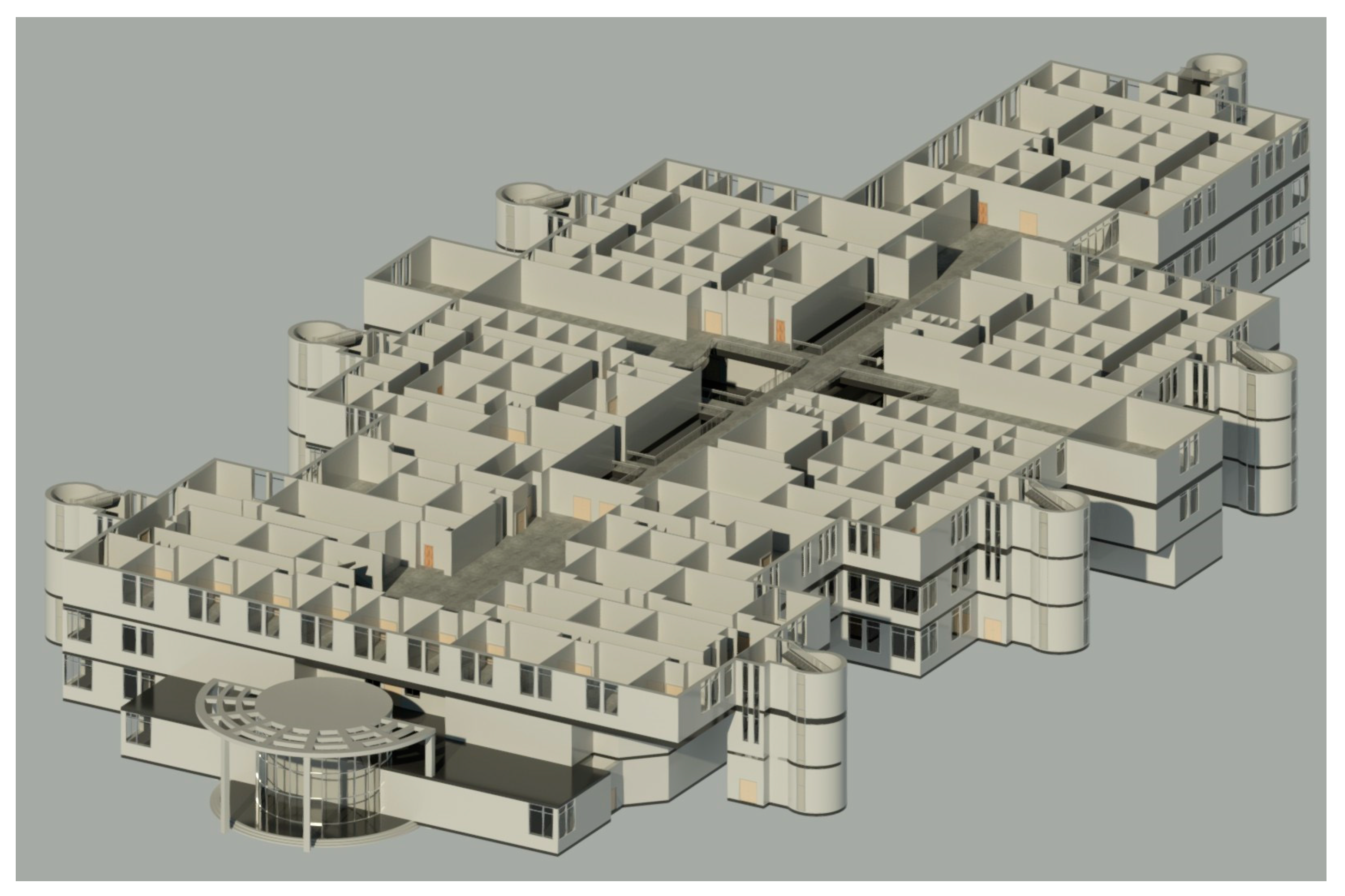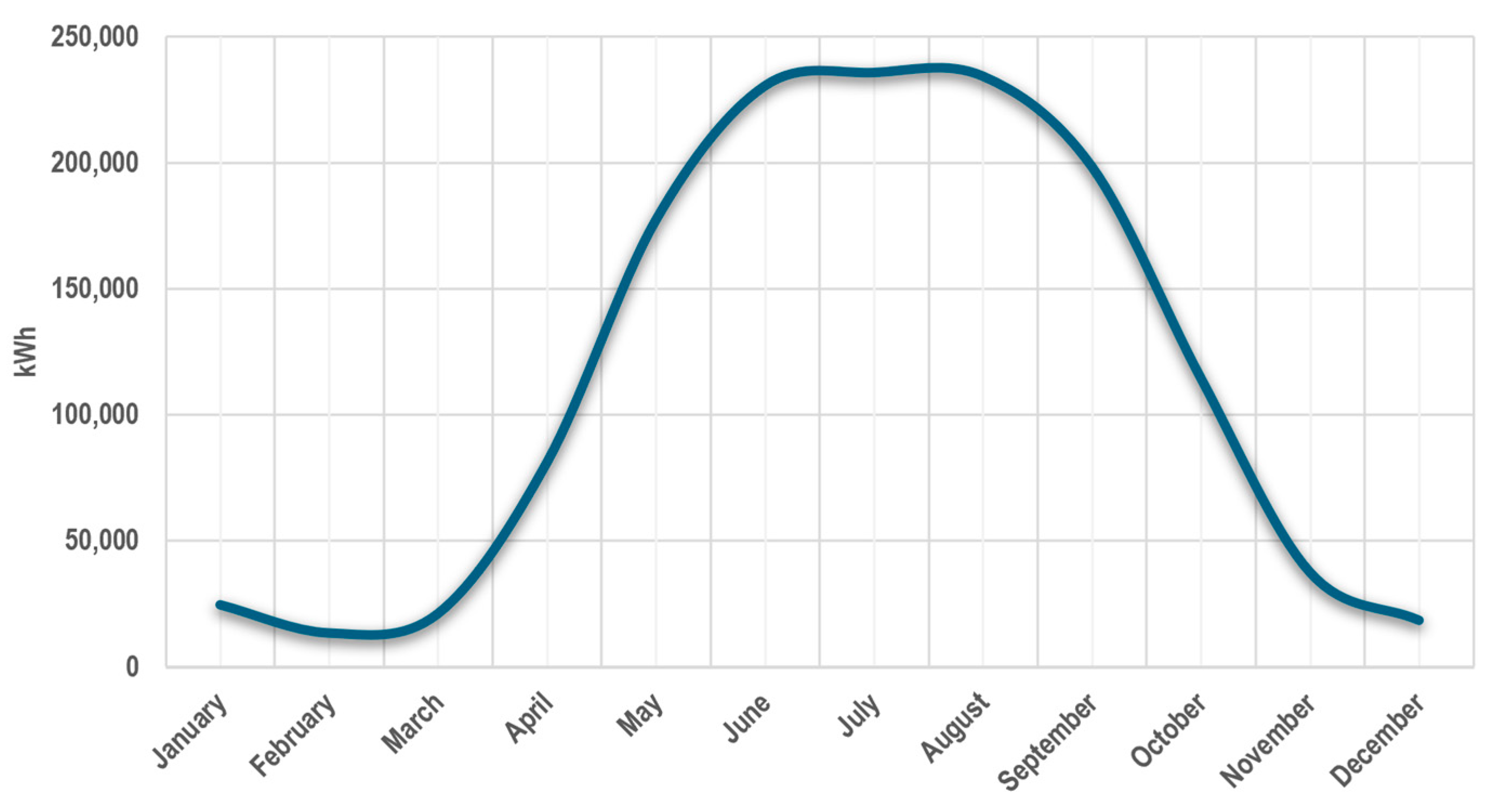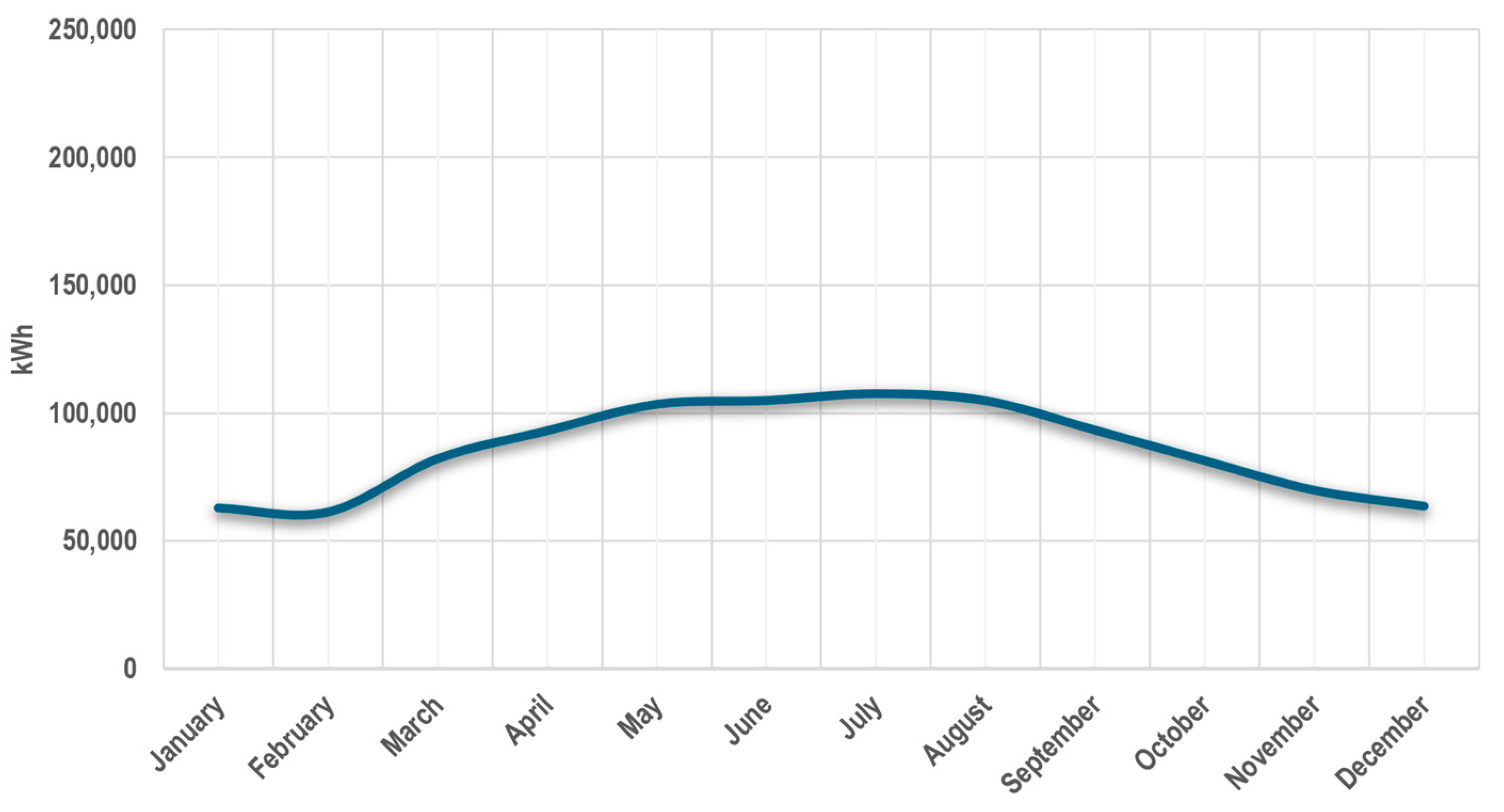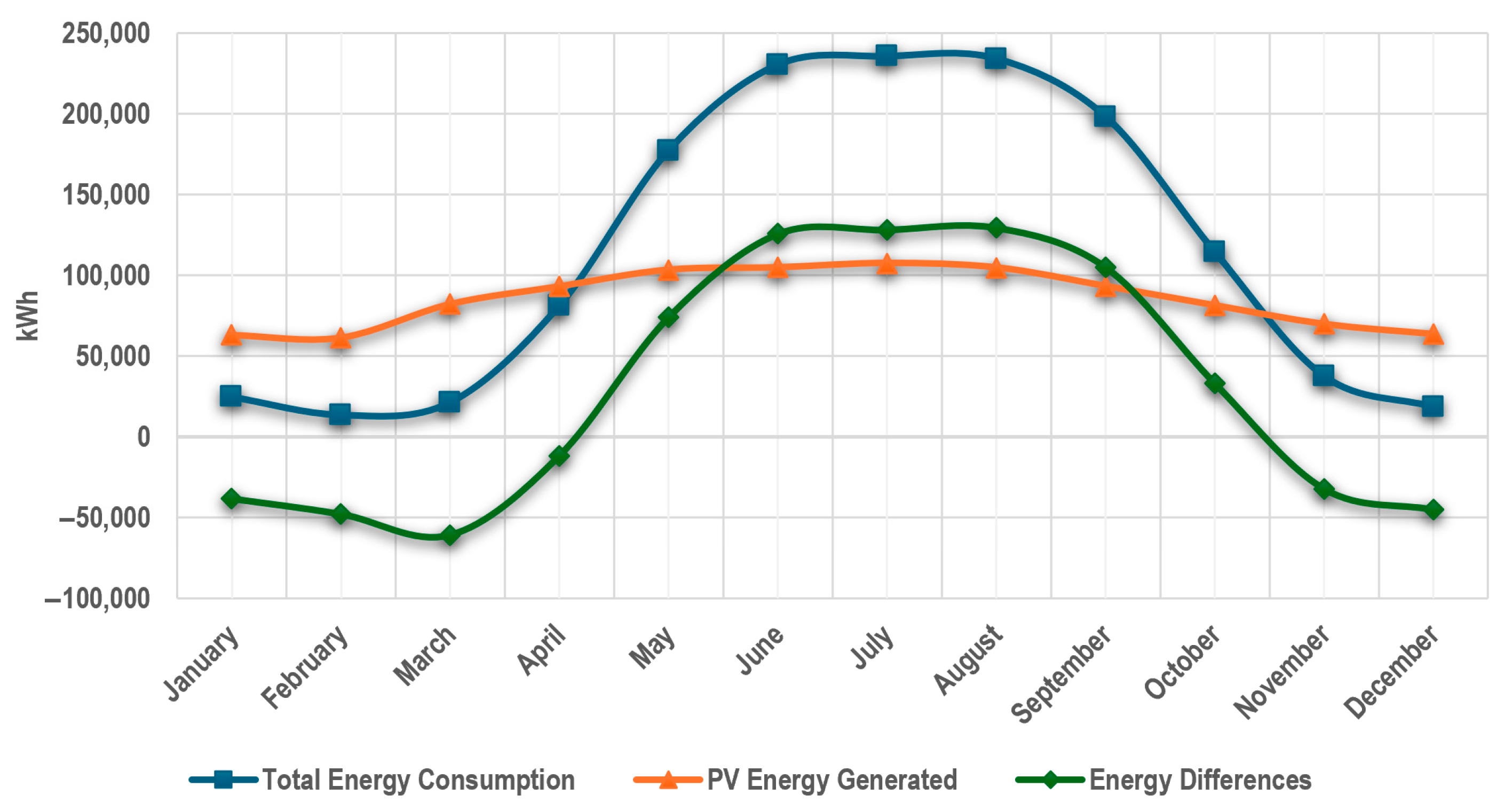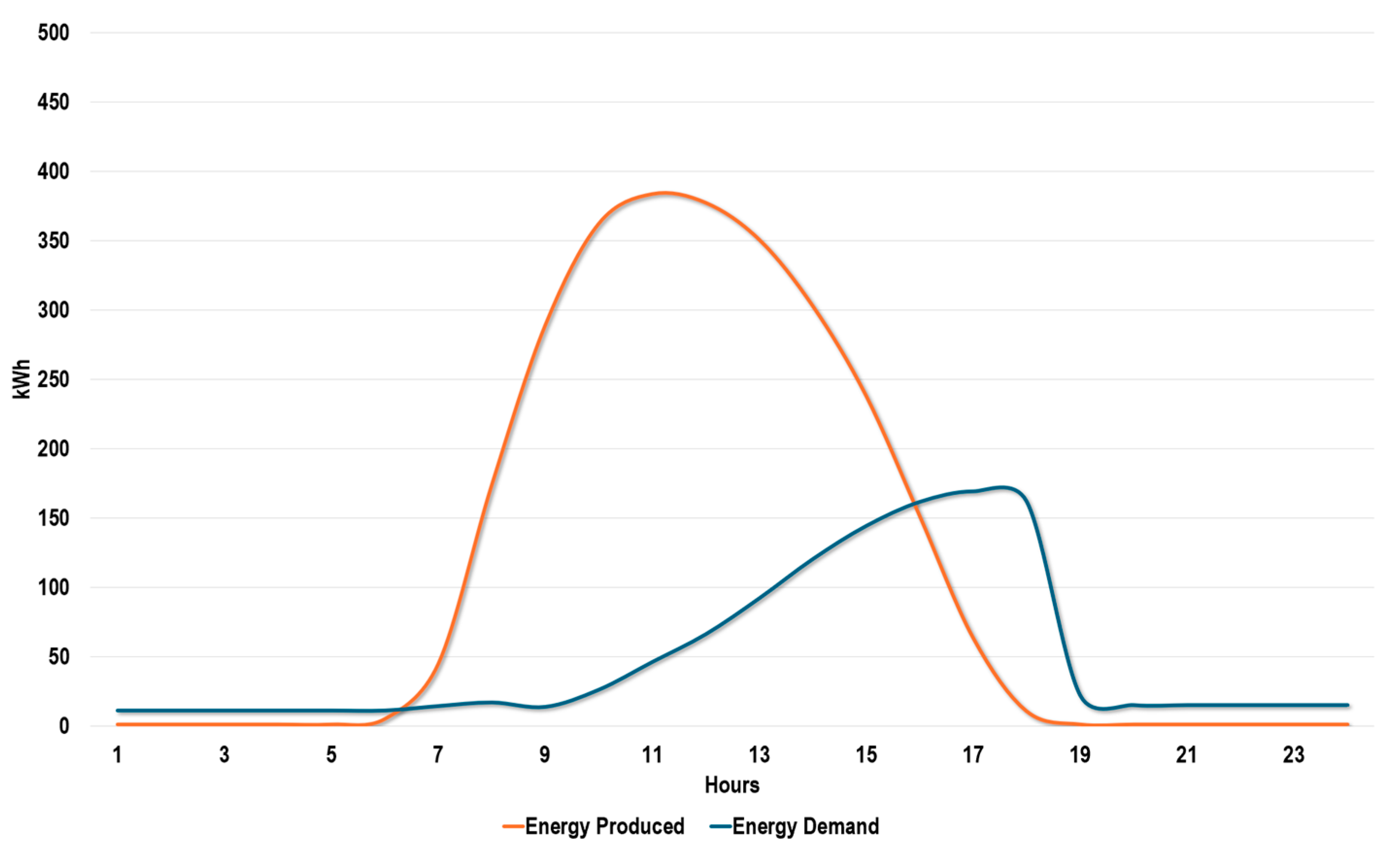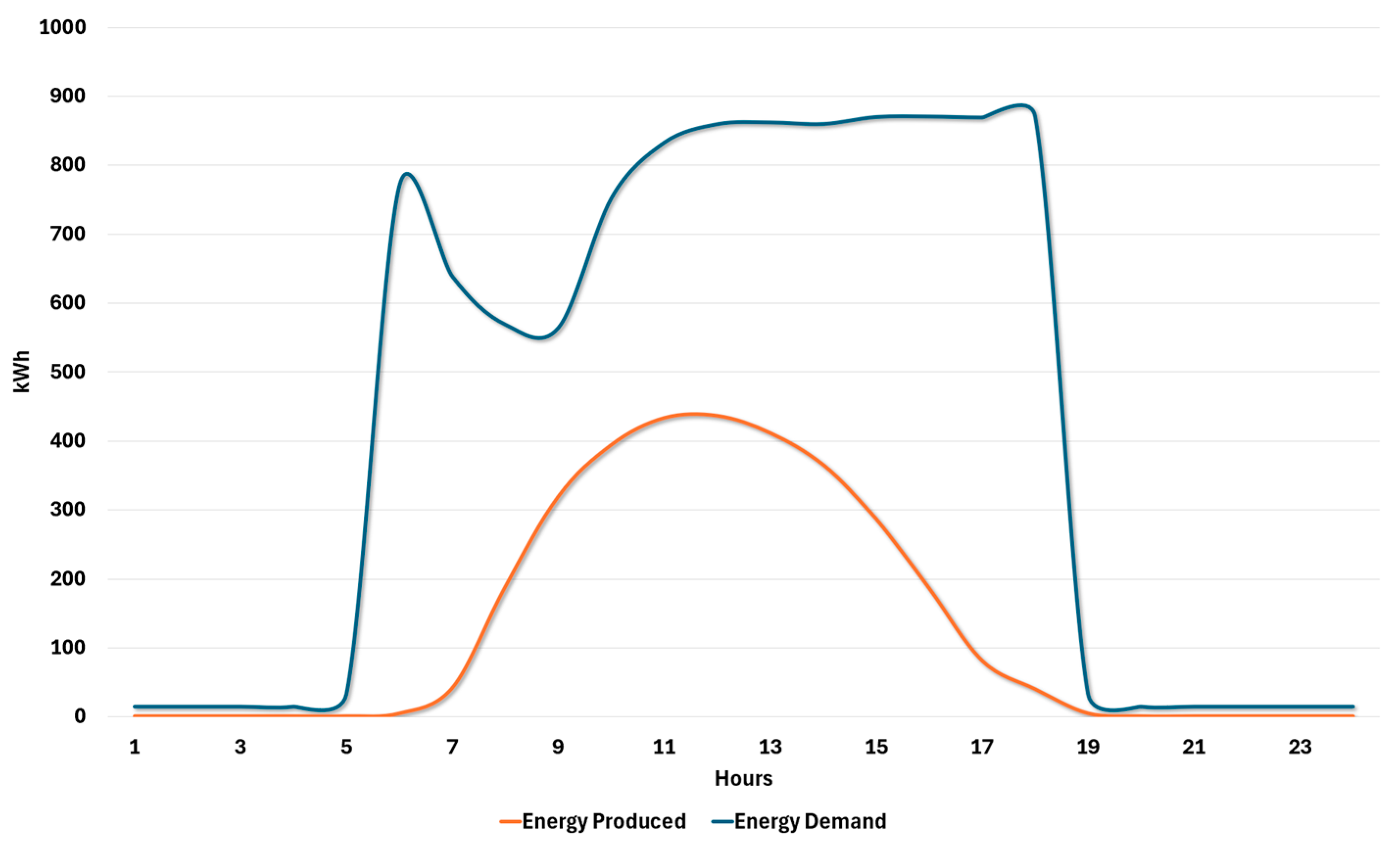1. Introduction
Several countries are focusing on reducing their dependence on fossil fuels and transitioning to sustainable energy systems. Renewable energy plays a crucial role in this effort, addressing the challenges of greenhouse gas (GHG) emissions, climate change, and rising global energy demand. This demand is driven by a projected global population increase of 1.3 billion by 2030 [
1,
2]. By 2030, the Kingdom of Saudi Arabia (KSA) aims to generate 50% of its energy from renewable sources, and the United States and Europe are targeting net-zero energy for residential and commercial buildings by 2050 [
3,
4]. The European Union (EU) has already surpassed its 2020 goal, reducing GHG emissions by 34% compared to 1900 levels, largely due to increased renewable energy adoption [
5]. Energy efficiency regulations for new buildings in the EU also support this progress, as the building sector accounts for over 40% of the region’s total energy consumption. However, more than 160 million buildings in EU countries were constructed before the implementation of these regulations [
6].
Renewable energy technologies are selected based on their intended application and spatial requirements. For instance, wind turbines require sufficient space for installation and specific climatic conditions, such as consistent wind at a particular speed. Similarly, solar panels require an adequate area for optimal orientation and positioning, as well as favorable climatic conditions to maximize sunlight exposure while minimizing shading and weather-related effects such as clouds, fog, and snow [
7,
8]. Among such technologies, photovoltaic (PV) systems have demonstrated remarkable growth and adaptability, providing a sustainable means of harnessing solar radiation. Methods used to estimate solar radiation potential include the digital surface model (DSM), which calculates solar radiation by analyzing sunlight reflected from building surfaces, and light detection and ranging (LiDAR), which generates three-dimensional (3D) surface models as inputs for DSM analysis [
9,
10]. PV systems are increasingly integrated into buildings, especially rooftops and facades, delivering economic benefits by reducing energy bills and promoting urban sustainability by reducing peak energy demand [
11]. Silicon-based solar cells are most commonly used due to their widespread availability and minimal environmental impact. However, successful implementation requires attention to shading, optimal placement, and local climatic conditions to ensure maximum electricity generation efficiency [
12,
13].
The building sector, responsible for over 40% of global energy consumption and 30% of GHG emissions, is a major focus for energy efficiency improvements. Rising demand for thermal comfort, driven by climate variability, emphasizes the need for innovative solutions such as PV systems. These systems can reduce energy consumption and lower cooling loads through shading effects, particularly in hot and humid climates. Studies have reported a 2% reduction in cooling demand and up to 19% overall energy savings when PV panels cover 75% of a rooftop area [
14,
15]. Globally, households often aim to cover up to 70% of rooftops with PV systems to maximize these benefits. However, such extended coverage requires large battery storage capacity, and some countries lack access to advanced battery technologies [
16]. A commonly overlooked factor is shading from nearby tall buildings or rooftop equipment such as water tanks and air conditioning units. To encourage PV adoption, governments often provide subsidies, especially in countries with high electricity tariffs. In contrast, in countries like Qatar, where electricity is free for national residents, there is little financial incentive for saving measures or PV installation.
High energy consumption is largely driven by the need to meet occupant thermal comfort expectations, which evolve with changing climate conditions. Educational buildings, in particular, incur high energy costs to maintain a stable comfort level, which is essential for students’ well-being and productivity. Several studies have examined how climate influences occupants energy use behavior [
17,
18,
19]. However, these behavioral patterns do not directly apply to educational buildings, which operate under unique conditions. Such buildings typically follow fixed schedules, with activity concentrated on workdays during specific hours, reduced activity levels in summer, and variable operational hours used across the academic year [
20,
21,
22]. In the KSA, which remains heavily dependent on fossil fuels and emits 15 metric tons of CO
2 per capita annually, transitioning to renewables presents unique challenges. With energy demand rising by 19% annually, which is driven by population growth and significant infrastructure development, the country aims to generate 9.5 GW of clean energy by 2030 [
23]. By the end of 2018, PV projects had reached a total installed capacity of 1.3 GW. For example, the Aramco oil company installed PV panels with a capacity of 10 MW. To promote further renewable energy adoption, policies such as net metering have been introduced to support small-scale PV integration in urban residential areas.
Building energy simulation software, such as EnergyPlus and DesignBuilder, plays an essential role in modeling and estimating buildings’ energy performance. The results of the modeling can be used to understand energy performance and support further analysis to aid building facility management in existing buildings and assist design teams for new constructions. These software applications enable engineers and designers to simulate various building parameters, including building geometry, HVAC systems, occupancy levels, and thermal properties, to estimate building energy consumption. The accuracy of these estimates depends on the precision of the parameters used in developing the simulation model. Therefore, when modeling PV energy production using energy simulation models, several parameters need to be considered. These include orientation, tilt, efficiency, and properties of the panels, as well as building location, weather data, and shading from surrounding buildings. A vital step is analyzing the building’s energy consumption to assess the effectiveness of the system to be potentially installed. The effectiveness can be measured based on whether the system meets the building’s energy demand fully or partially and the investment returns, thereby promoting sustainable building practices and optimizing energy use.
Studies have employed various methods to evaluate the effectiveness of rooftop PV panels in reducing energy consumption, cooling loads, and shading effects. These include satellite imaging, regression analysis, and simulation modeling [
24,
25]. Among them, simulation tools are widely used due to their ability to model building energy consumption over time based on multiple inputs. The higher the resolution and accuracy of the input data, the better the model simulates real-world conditions. Tools such as EnergyPlus include built-in weather data; however, additional datasets can be imported to improve accuracy. Nonetheless, uncertainties in input data can influence model accuracy, especially when weather data remains a notable area requiring further research [
26,
27,
28]. Simulation tools often rely on historical weather data (typical meteorological years), which may not accurately reflect future climate conditions. Accurate weather inputs are essential for generating reliable simulations that can inform energy policy and emission-reduction strategies [
29,
30]. Energy simulation tools, such as EnergyPlus and DesignBuilder, are commonly used to estimate energy consumption across various building types, including residential, office, and university buildings. They also allow researchers to explore the integration of systems such as PV panels [
31,
32,
33,
34,
35,
36,
37,
38] and to analyze building performance throughout the year under changing climate conditions [
39,
40,
41,
42,
43,
44].
PV panel installation has become increasingly common in both new and existing residential buildings. Hoseinzadeh et al. [
45] conducted a study in Iran aimed at achieving net-zero energy consumption in residential buildings through PV panel installation. An energy simulation model evaluated the effectiveness of installing an average of 63 m
2 of PV panels over eight months of energy simulation. Simulation results showed a reduction in the building’s energy consumption for the heating, ventilation, and air conditioning (HVAC) system from 34 to 7 MW, along with a potential government annual return of USD 15,000. Similarly, Al Huneidi et al. [
46] developed a simulation model to analyze energy consumption after rooftop PV installation in a residential villa in Qatar. Their results demonstrated substantial energy saving in hot climates. However, single-building studies often assume optimal conditions, ignoring seasonal variability and other factors such as shading, which limit the generalization of these studies. Dehwah and Asif [
47] analyzed the effect of PV panel installation on 33,000 residential buildings in the KSA, simulating energy consumption for 12 months using DesignBuilder and accounting for factors such as solar radiation, panel orientation, and shading. When 25% of rooftops were covered with PV panels, energy consumption dropped by 19%. The higher efficiency gains can be associated with the panel cover assumptions and the system inclusion losses. PV integration has also extended to non-residential buildings. A study by Costanzo et al. [
48] estimated energy consumption of a university building using EnergyPlus simulation tool to evaluate the effect of PV panel installation. The model simulated three scenarios: the actual energy consumption, energy efficiency improvement after implementing energy-saving measures, and consumption after PV integration. PV installation led to a 23% reduction in energy use, surpassing expectations by 2%. Similarly, Popa and Brumaru [
49] assessed the energy consumption of an office building in Romania using DesignBuilder. PV panels were installed on the facades to improve thermal control in summer and winter, resulting in appreciable energy savings and reduced utility bills. Zheng and Weng [
50] aimed to model the effect of PV on energy savings. The study also examines green roofs to help reduce climate change. The case study was conducted in California, US. Future climate conditions for 2050 were modeled to evaluate their impact on building energy consumption and the resulting energy savings. EnergyPlus software was used to estimate PV energy production and input weather data. The results indicate a reduction in energy use when integrating the systems, mainly for the HVAC system. The limitation in modeling green roofs in EnergyPlus is related to the type of plants, as there are limited options, and the fact that they grow is not considered.
Simulation tools also play a notable role in improving building energy consumption performance. An-Naggar et al. [
51] developed an energy consumption simulation model for a 100 m
2 apartment in Egypt, comparing two scenarios: one with thermal insulation applied to walls and roofs, and another scenario without thermal insulation. Using DesignBuilder, the five-month simulation showed that thermal insulation reduced energy consumption by 40%, considerably lowering utility costs and decreasing CO
2 emissions by 30%. Ashrafian [
52] investigated the impact of climate change on energy consumption and the associated cost in a five-story school building in Turkey with 480 students. The study used DesignBuilder to estimate the building’s energy consumption over 12 months. A key challenge in developing the simulation model was the uncertainty of weather data, as the initial inputs relied on historical records. This was addressed by incorporating future climate projections, which were validated against past data. The model also evaluated different roof coverages ranging from 20% to 80% with PV panels. The findings highlighted that even in highly efficient buildings, weather and occupant behavior notably influenced energy consumption performance. Collectively, these studies reported higher savings when dealing with small-scale and short-term models. In contrast, large-scale models consider the climate projected in the simulation to yield more conservative estimates. Since occupant presence directly influences energy consumption, several studies have proposed predictive models to estimate future occupancy patterns, which serve as inputs for developing building energy simulation models [
53,
54].
This paper aims to assess the effectiveness of integrating photovoltaic (PV) systems within a real-world educational building context, measuring their energy production in relation to energy demand and their economic impact. The methodology involves creating an architectural model in Revit to develop a 3D structure and position PV panels, enabling the study of potential shadowing effects. Additionally, a comprehensive simulation model is developed using DesignBuilder for a high-density, higher-education building in KSA. Using the developed simulation model, this research thoroughly assesses the potential electricity generation from the PV system installed on the building’s rooftop. A series of comparative analyses is performed to evaluate the system’s performance across different seasons, offering critical insights into its operational efficiency. Furthermore, a detailed economic analysis is conducted, which includes a complete payback period assessment to determine the financial viability of the PV system over its 30-year lifespan. The results of this research highlight the energy and cost-saving benefits of PV panel integration and underline the importance of coordinated technical, regulatory, and economic strategies. These strategies are essential for achieving long-term energy sustainability and significantly reducing reliance on fossil fuels. The implications of this study contribute to the broader discussion on sustainable energy solutions, making it a valuable resource for policymakers, educational institutions, and the construction industry committed to promoting renewable energy adoption and improving energy efficiency in building design.
3. Results
This section presents the results of the study in four stages: first, identifying the building’s usable rooftop area for PV panel placement; second, developing architectural and energy consumption simulation models to estimate the building’s baseline energy demand; third, analyzing the placement of PV panels using the developed models and estimating the corresponding electricity generation; and finally, assessing the economic benefits, including energy bill savings and the investment payback period.
The initial stage involved identifying the rooftop areas suitable for PV panel placement and those that must remain unused. The rooftop cannot be fully covered with PV panels due to the requirements for circulation spaces (e.g., walking paths and maintenance access), the presence of existing structures such as shafts, skylights, and rooms up to 3.6 m in height, and shaded zones unsuitable for panel installation. The study focused on the rooftop of the university’s architectural building, which has a total area of 7175 m
2. Based on the aforementioned constraints, approximately 16% (1148 m
2) is allocated for circulation, 14% (1004.5 m
2) occupied by existing structures, and 10% (717.5 m
2) is shaded, leaving 60% (4305 m
2) of the rooftop available for PV panel placement.
Figure 3 illustrates the color-coded zoning of the rooftop, highlighting the areas reserved for circulation, shading, and PV panel placement.
The second stage involved estimating the reference building’s annual energy consumption to estimate its baseline energy demand. This estimation was performed through the development of comprehensive architectural and energy consumption simulation models. Autodesk Revit 2026 (v26.0.10.8) was used to create the architectural model of the building at LOD 3, ensuring higher geometric accuracy and accurate location data compared to previous studies, which typically relied on LOD 1 mass models.
Figure 4 shows the internal layout of the building, including interior walls, doors, and windows.
The Revit architectural model was then imported into the DesignBuilder energy consumption simulation software (v7.3.1.003) to develop the comprehensive building energy consumption simulation model. Inputs included detailed HVAC system specifications (as described in
Section 2.1), occupancy schedules, lighting types, and other relevant parameters used to estimate the building’s energy consumption.
Figure 5 shows the estimated energy consumption results of the case study building using DesignBuilder. The estimated average annual energy consumption of the reference building was 138,860 kWh, corresponding to an accuracy of 92.28% when compared to the actual data of 150,480 kWh provided by the building’s facilities management department. It validates the potential for predictive modeling and decision-making support in similar facilities. Energy consumption reveals a clear seasonal trend, which is strongly influenced by climate conditions. The data underscores the significant impact of cooling loads during the summer months, with June, July, and August showing the highest energy usage, averaging over 230,000 kWh monthly. The high energy demand during summer months is related to extreme ambient temperatures and continuous HVAC operation for building occupants’ thermal comfort, as some classes are ongoing. The temperature in summer often exceeds 45 °C (113 °F), which makes this period crucial in driving energy consumption patterns throughout the year.
In contrast, the substantially lower energy consumption between January and March, as well as in November and December, illustrates how cooler ambient conditions reflect on reduced HVAC demand. The lowest energy consumption was observed in February, at 13,656 kWh. Additionally, occupancy-related factors, such as academic holidays during winter break, are likely to contribute to this decline. There was a steep rise in energy consumption from March to May. In April, energy consumption increased by more than three times, rising to 81,332 kWh compared to 24,825 kWh in January. Energy consumption was higher in May, at 177,448 kWh, marking the beginning of the high consumption period. Notably, May coincides with final exams, suggesting extended building usage during critical academic periods. The sharp decline after August can be associated with lower demand for HVAC systems due to the drop in climate temperature.
The third stage involved placing PV panels within the developed models and calculating the resulting electricity generation. The PV panel placement strategy is shown in
Figure 6. PV panels were positioned on the building’s rooftop in the 3D Revit model, which also facilitated shading analysis. Shaded areas caused by existing rooftop structures were avoided during the placement of the PV panels. Subsequently, an energy consumption simulation model incorporating the rooftop PV panel layout was developed in DesignBuilder to estimate electricity generation. As established earlier, 60% of the rooftop area was deemed suitable for PV panel placement. The simulation results indicated that 830 PV panels, covering a total area of 2145 m
2, could be accommodated within the usable rooftop space.
The simulated monthly electricity generation from the PV panels over one year, showing a clear seasonal pattern, as presented in
Figure 7. The output is influenced by environmental parameters such as weather conditions (e.g., cloud cover and rainfall), ambient temperature, solar irradiance, and daylight duration. The analysis identified three distinct levels of electricity generation: high, moderate, and low.
Peak electricity generation was recorded in July (107,510 kWh), followed by June (104,824 kWh), August (104,780 kWh), and May (103,365 kWh), reflecting the period of highest solar exposure during the summer months. These conditions enhance photovoltaic conversion efficiency due to longer days and more direct sunlight incidence. A moderate generation level of electricity was observed during March, April, September, and October. During these months, the daylight is still substantial but gradually increasing (in spring) or decreasing (in autumn). March yields the highest in this category with 93,315 kWh, while October had the lowest at 81,430 kWh, possibly due to the early onset of cloudier weather and reduced sunlight angle. The lowest generation levels occurred during winter, from November to February. February recorded the minimum (61,407 kWh), followed by January (63,033 kWh), December (63,741 kWh), and November (69,902 kWh). The reduced electricity generation during this period was primarily due to shortened daylight hours, solar angles, and increased cloud cover. Lower ambient temperatures, which are beneficial to PV efficiency in theory, are often offset by weather-related losses, such as dense cloud layers.
The fourth and final stage involves evaluating the effectiveness of the PV panel installation on a high-density higher-education building by comparing the building’s total estimated annual energy consumption with the electricity generated by the PV panels. This comparative analysis assesses the extent to which the PV panels can meet the building’s energy demands.
Table 2 and
Figure 8 present the annual energy consumption of the reference building, the electricity generated by the PV panels, and the monthly differences between the two.
The results reveal seasonal variations in the balance between electricity generation and consumption. Surplus energy was recorded during the cooler months—January, February, March, April, November, and December—when the building’s energy demand was comparatively lower. During these months, the PV panels generated more electricity than required, with the excess potentially fed into the grid. The highest surplus, exceeding 60,000 kWh, occurred in March. Conversely, during the summer months (May–August), when outdoor temperatures in Dammam City rose considerably, the building’s cooling loads increased sharply, leading to substantially higher energy demand. During this period, electricity consumption consistently exceeded electricity generation, with the highest deficits recorded in June, July, and August, each exceeding 125,000 kWh. Although the building’s rooftop was fully utilized for PV panel installation, the system could not meet the total energy demand during the peak summer months. This highlights the need for supplementary energy sources—either from the national grid or through battery storage—to ensure uninterrupted operation. Overall, the PV panels generated 1,028,494.50 kWh of electricity annually, covering 61.7% of the building’s total energy demand of 1,666,318.25 kWh. This substantial offset demonstrates the PV panel’s effectiveness in reducing dependence on external energy sources and achieving significant cost savings.
The analysis of hourly energy balance between photovoltaic (PV) generation and building electricity consumption across four representative months shows clear seasonal and daily fluctuations in both supply and demand patterns.
Figure 9,
Figure 10,
Figure 11 and
Figure 12 display the average hourly energy for March, April, August, and December, comparing the building’s energy consumption with PV production. In March, as shown in
Figure 9, PV output peaks at around 380 kWh between 10:00 and 11:00, resulting in exceeding the building’s relatively low demand caused by cooler temperatures in the hot climate zone, eliminating the need for cooling. Late afternoon demand still requires grid support. A similar profile occurs in November. April, shown in
Figure 10, exhibits a different energy profile. The peak energy produced by PV is slightly higher than the building’s energy demand. The PV peaks near 470 kWh at 11:00, marginally higher than the demand, which was around 450 kWh, and occurs from 14:00 to 17:00. The total energy generated by PV over the day can cover about 80% of the energy demand. When distributing the energy produced throughout the day, it fully meets the building’s energy demand from the start of the day until noon. After that, it limits the midday surplus because the demand exceeds PV energy production. This profile also appears in October. In August, as shown in
Figure 11, energy demand peaks occurred during the summer months. The energy demand ranged from 850 to 880 kWh between 09:00 and 17:00, while PV peaks at about 430 kWh, accounting for 30% of the consumption. This profile, observed from May to September, limits coverage to a maximum of 40% and highlights the necessity of being connected to the grid. December, as shown in
Figure 12, has the lowest PV peak of about 370 kWh at 11:00, typical of winter. However, the low building energy demand allows PV to surpass energy consumption during daylight, except for a small pre-sunrise peak of around 150 kWh. A similar energy profile occurs in January and February.
Collectively, these energy profiles demonstrate a strong seasonal dependence of PV energy production and building energy demand. The seasonal effects of summer and winter are illustrated in the energy profiles, emphasizing the importance of energy management strategies to maximize self-consumption and reduce grid dependence. During winter, excess PV energy produced can be exported to the grid, while in summer, PV output may not fully meet the energy demand, requiring grid purchases. Since the PV system covers roughly 61.7% of annual demand, off-grid operation with battery storage is not necessary, and maintaining a grid connection remains cost-effective.
In terms of evaluating the economic viability of the PV system, an analysis of cost savings and potential investment payback periods was conducted. This required determining the electricity tariff applicable to the reference building, which is categorized as a governmental educational facility. According to the Saudi Electricity Company (Marafiq, Riyadh, Saudi Arabia), the tariff for this category is USD 0.0854 per kWh [
74]. The price of electricity in Saudi Arabia remains relatively fixed due to government subsidies. Based on this rate, the annual energy cost for the case study building, calculated using its total electricity consumption of 1,666,318.25 kWh, was compared with the price of the energy produced by the PV system in the first year, which was 1,028,494.50 kWh.
Table 3 presents the cost-saving results, showing that the PV system yields annual savings of USD 87,764.86, covering 61.7% of the building’s total electricity expenses.
Table 4 provides a monthly breakdown of cost savings, with July recording the highest savings (USD 9174.15) and February the lowest (USD 5240.05). The average monthly savings from PV-generated electricity amounted to USD 7313.74. These results demonstrate that implementing the PV system offers notable economic benefits, particularly in regions with high solar irradiance and abundant sunlight.
To assess the economic benefits of the PV system, a cost–benefit analysis was performed to estimate the investment payback period and overall financial viability. The study incorporated key parameters, including capital expenditure (CAPEX) associated with the installation cost, operational expenditure (OPEX) for annual maintenance, annual savings from electricity generation, and the investment payback period required to recover the initial investment.
Table 5 presents the input parameters and calculated values. The capacity of the PV system installed on the building was 1,028,494.50 kWh, achieved using 830 panels. The installation cost was estimated at USD 640 per kW, resulting in a total CAPEX of USD 531,200. The annual maintenance cost (OPEX) was calculated at 1.5% of the total system cost, amounting to USD 7986 per year. The maintenance includes regular inspection, cleaning of dust, and preventive maintenance. The annual net savings were determined by subtracting the maintenance cost from the gross savings based on the PV output and electricity tariff (USD 0.0854/kWh). The annual energy savings were USD 87,764.86, with a net savings amount of USD 79,796.86. In order to calculate the investment payback period, the degradation of PV performance needs to be taken into account. Based on the PV manufacturer’s data, the degradation ratio over 25 years is 1% in the first year and 0.4% in subsequent years. Thus, the profit in the first year, considering energy production with 1% degradation and 1.5% maintenance, is USD 78,987.10, with an energy output of 1,018,209.56 kWh per year. The profit gradually decreases as PV degradation decreases by 0.4%, reaching an accumulation of 10.6% in year 25. By that year, energy production had dropped to 924,828.68 kWh/year, meeting 55.5% of the building’s energy demand.
Table 6 displays the energy produced over the PV system’s lifespan, decreasing by 1% and 0.4%, along with the fixed maintenance cost of USD 7968 based on system size, and the resulting profit.
Based on these figures, the investment payback period is calculated for the expected PV system lifespan of 25 years, which was under 7 years.
Table 7 summarizes the payback calculation, considering the PV system’s expected lifespan of 25 years. This indicates that the system becomes cost-neutral in under 7 years and continues to generate financial returns for an additional 18 years. Over its operational lifetime, the PV system is projected to save USD 1,873,462, nearly three times the initial investment, demonstrating that rooftop PV integration is a financially profitable and sustainable strategy for enhancing a building’s energy self-sufficiency.
